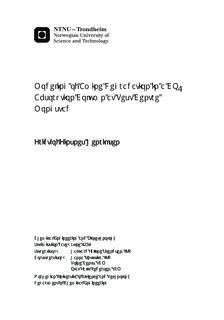Modeling of Amine Degradation in a CO2 Absorption Column at Test Centre Mongstad
Abstract
Two different previously conducted oxidative degradation experiments, were used as a basis of modeling monoethanolamine-degradation reactions. Literature and previous experience was used to construct reaction equations for the formation of five main degradation products; ammonia, N-(2-hydroxyethyl)formamide (HEF), N-(2-hydroxy ethyl)imidazole (HEI), N,N?-Bis(2-hydroxy ethyl)oxalamide (BHEOX) and N-(2-hydroxy ethyl)glycine (HEGly), in addition to four intermediate products formaldehyde, formic acid, glyoxal and oxalic acid.
Rate equations were developed for the reactions, and implemented in the degradation model. The model was thereafter fitted to the experimental data of both experiments, to provide parameters in the rate equations.
The found parameters and rate equations were implemented in an obtained Aspen Plus absorber simulation. Three different absorber cases were created, with two different flue gas compositions. The ammonia emission in the simulation results ranged within reasonable 9.6 - 14.6 ppmv. However, a rough estimation of the degradation rate, showed that the rate in the simulations was much higher than previously measured in pilot plants.
The results showed that the data set used for the modeling was too small to provide a complete degradation model. This resulted in several weaknesses in the model, such as independence of CO2-loading, temperature, contaminates and instability with respect to the concentration of dissolved ferric. Yet, the results also showed that it was possible to model degradation reactions in detail, and that further development of the model had good potential if more experimental data would become available.
